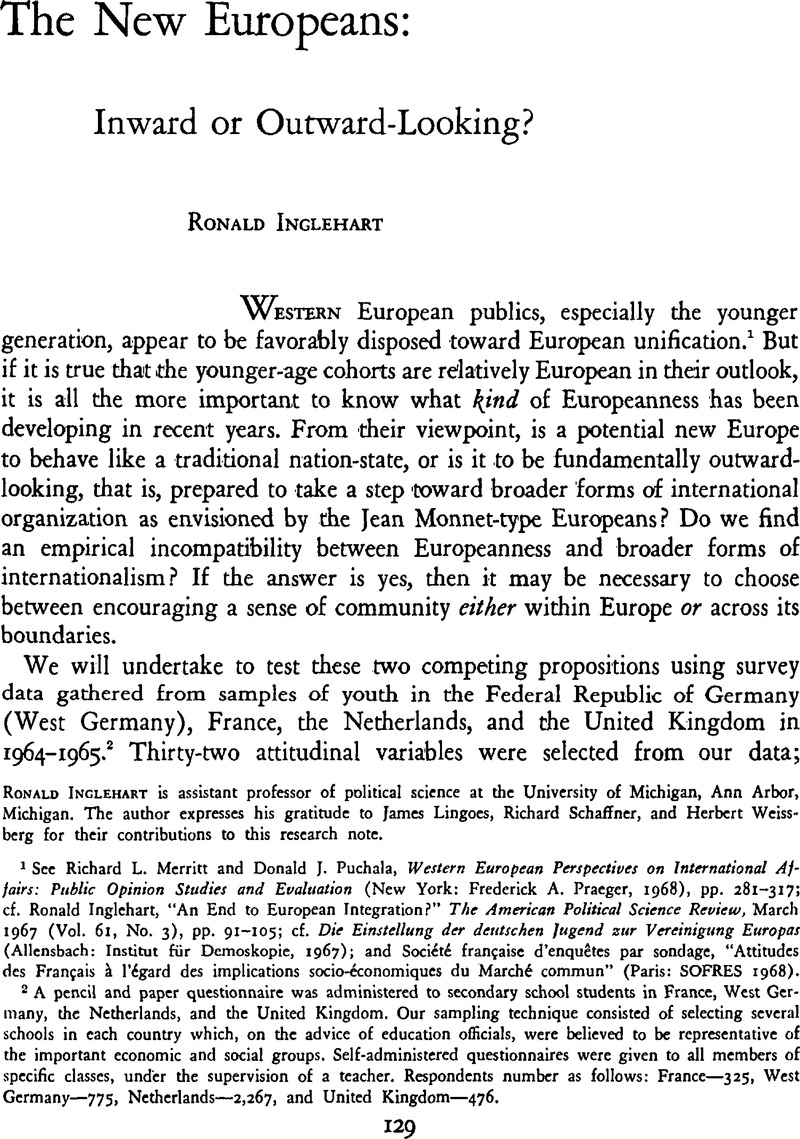Article contents
The New Europeans: Inward or Outward-Looking?
Published online by Cambridge University Press: 22 May 2009
Abstract

- Type
- Notes on Theory and Method
- Information
- Copyright
- Copyright © The IO Foundation 1970
References
1 See Merritt, Richard L. and Puchala, Donald J., Western European Perspectives on International Affairs: Public Opinion Studies and Evaluation (New York: Frederick A. Praeger, 1968), pp. 281–317Google Scholar; cf. Inglehart, Ronald, “An End to European Integration?” The American Political Science Review, 03 1967 (Vol. 61, No. 3), pp. 91–105CrossRefGoogle Scholar; cf. Die Einstellung der deutschen Jugend zur Vereinigung Europas (Allensbach: Institut für Demoskopie, 1967)Google Scholar; and Société françhise d'enquetěs par sondage, “Attitudes des Français à l'égard des implications socio-économiqucs du Marché commun” (Paris: SOFRES 1968)Google Scholar.
2 A pencil and paper questionnaire was administered to secondary school students in France, West Germany, the Netherlands, and the United Kingdom. Our sampling technique consisted of selecting several schools in each country which, on the advice of education officials, were believed to be representative of the important economic and social groups. Self-administered questionnaires were given to all members of specific classes, under the supervision of a teacher. Respondents number as follows: France—325, West Germany—775, Netherlands—2,267, and United Kingdom—476.
3 See Guttman, Louis, “A General Nonmetric Technique for Finding the Smallest Coordinate Space for a Configuration of Points,” Psychometrika, 12 1968 (Vol. 33, No. 4), pp. 469–506CrossRefGoogle Scholar; cf. Lingoes, James C., “An IBM 7090 Program for Guttman-Lingoes Smallest Space Analysis—I,” Behavioral Science, 04 1965 (Vol. 10, No. 2), pp. 183–184Google Scholar; andLingoes, James C., “New Computer Developments in Pattern Analysis and Nonmetric Techniques,” in Uses of Computers in Psychological Research (Paris: Gauthier-Villars, 1966), pp. 1–22Google Scholar.
4 The program yields solutions in from one to ten dimensions, the number needed depending on the complexity of the input data. For cases requiring k factors in a standard linear factor analysis a smallest space analysis will never yield more than k dimensions and, in general, will yield substantially fewer. The more complex the interrelations, die more dimensions required to reflect the pattern or configuration. Typically three dimensions or less are sufficient to reflect the main features of die order relations.
5 The “Civism” items were adapted from a series of questions developed by Noizet, Georges and Pierre, Jean-William La in research on civisme: See Une recherche sur civisme des jeuncs à la fin de la quatrième Republique (Aix-en-Provence: Publication des annales de la Faculté des lettres, 1961)Google Scholar. Highloading items on a French Civism factor concerned tolerance or disapproval of cheating on personal income tax (loading =.500), emigration (loading =.427), riding on (national) trains without buying a ticket (loading =.376), a common European foreign policy (loading =.365), and the French nuclear force (loading = -.348).
6 The abbreviated tides of the asterisked items on both the SSA plots and the factor loadings refer to the following questions:
“Federal European government”: a proposal to establish a federal European government “with power to make some laws which are binding in each member nation.” Majorities of both the German and Dutch samples supported this proposal (55 percent and 59 percent, respectively); a thin plurality among the French sample supported it, and a 55 percent majority of the English sample opposed it.
“European army”: a proposal to establish one unified army for Western Europe. This item was favored by strong majorities in die Dutch and German samples, rejected by a heavy majority of the English, and not asked in France.
“Free movement”: a proposal to permit free movement of workers and businesses between die countries of Western Europe. This item was supported by majorities of at least 60 percent in all four countries.
“For European unification”: “To what extent are you for or against the attempts being made to unify Europe?” Favorable majorities ranged from 72 percent in Britain to 95 percent in the Netherlands.
“British membership”: support for British membership in the European Economic Community (EEC); this question was asked in all countries except France where it was altered to inquire about French membership in the EEC (“French member”). The item received the support of heavy majorities (about 70 percent) in each case.
“Abolish tariff”: a proposal to abolish tariffs among Western European nations. This and the following two items received majority support in all four countries.
“Foreign policy”: a proposal for the Western countries to have one common foreign policy.
“Aid Europe”: a proposal to use part of the taxes paid by (country) to aid the poorer countries of Europe.
“Aid Africa”: a proposal to use part of the respondent's country taxes to aid in the development of African countries. That the students respond to this item in much the same way as they do to more manifesdy European items attests to the outward-looking, rather dian exclusive, nature of their orientation.
7 Only the “Europeanness” factors will be presented here. The equivalent of the other factors will be discussed in the context of the smallest space analysis.
8 “UN flag” asks if the respondent approves of flying the UN flag beside the national flag on public buildings; “Nation v. UN” asks “which does more to keep the peace, [your country] or the UN?”
9 The cluster is based on consistent responses to the following items: “fear of unemployment is a necessary incentive to work”; “human nature being what it is, war and conflict are inevitable”; “people who don't get ahead just don't have enough will power”; “it is better to be too strict than too easygoing with children”; obedience is important as a virtue to teach children; and there is a need for clear and precise instructions from bosses and teachers.
10 This item is worded “Most people can be trusted… I agree/I disagree.”
- 23
- Cited by




